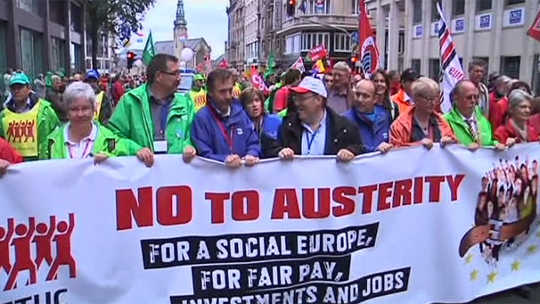
Leading economic think-tank the institute of Fiscal Studies has warned that “middle-income families are the new poor” – a damning indictment of the way poverty in Britain has spread far beyond groups that are traditionally considered poor. It’s the same story across much of Europe and is a product of the austerity agenda that has squeezed the middle class since the financial crisis.
The statistics in the European Union are depressing. Official figures report that 24% of its non-poor population (122m citizens) are currently at risk of descending into poverty or social exclusion. This means that they were either at risk of income poverty (their disposable income was below their national at-risk-of-poverty threshold), severely materially deprived and/or living in households with low work rates.
In Greece, Spain, Portugal and other countries that have been especially affected by debt crises and ensuing austerity policies, millions of medium to high-skilled workers, professionals, middle-managers, public sector workers, university graduates and small business owners face hardship.
These white-collar workers are a new problem for governments and welfare agencies to deal with and they are often ill-equipped to support them. Their superior levels of education and professional experience and networks should bestow them with significant advantages in the labour market.
But public sector redundancies, a growth in precarious patterns of work, increased global competition for labour, rising indebtedness and spiralling housing and childcare costs have all contributed to falling living standards. And the ranks of a “new urban poor” in Europe are swelling.
Standing on the precipice
Getting this group back on their feet is vitally important – for the citizens in question, but also for the economy as a whole. While it presents a new problem for Europe, there are some lessons to be learned from Argentina, which experienced a similar problem a decade ago.
Like many of these European states, Argentina is a liberal democracy with a market system, a welfare state tradition and G20 membership. It has also historically had a large middle class, comparable in size and political influence to that of many European societies.
Following its 2001-02 sovereign debt crisis – the most severe in global history prior to Greece’s – 7m of Argentina’s highly-educated citizens were thrown into poverty. Despite a decade of unprecedented macroeconomic growth when the country became the fastest-growing economy in the Western hemisphere, and 2m jobs were created, a third of them struggled to recover and remain unemployed or in low-paid, dead-end jobs.
Poisoned chalice
The plight of those affected can partly be explained by structural factors such as the economy’s failure to create sufficient quality employment or by age discrimination – but their experiences suggest that a more obscure explanation was at play. Paradoxically, many struggled to transform their abundance of educational, professional, physical and cultural assets into real-life benefits.
Indeed, in some cases it was these very resources that proved to be a poisoned chalice and prevented their recoveries. Unlike the long-term poor, many of these middle-class citizens were traumatised and completely disorientated by their sudden social descent, with no experience to draw from about how to deal with it.
Others remained in denial, seeking to maintain luxury spending patterns and ostentatious consumption. Though they could not afford it, keeping up the pretence that “all was well” to peers was judged the priority. Yet maintaining membership of their golf club, for example, while sacrificing basic necessities such as meals, utility bills or health insurance was worse for their health and finances in the longer-term. Ironically it was their access to affluent family members or close friends to borrow money that facilitated these counter-productive strategies.
The struggle to change
My research into the thinking of many of Argentina’s jobless professionals showed that they often endured long periods of unemployment. Many refused to take low-paid or less prestigious jobs because they represented a degradation in their employment status. They would look for work in the wrong places, focusing their job searches on answering adverts in only highbrow newspapers and trade journals.
In contrast they expressed great reluctance to use their networks to ask around for job opportunities (“personal referrals” is actually how employers most commonly recruit high-quality employees), for fear that the shameful reality of their unemployment would be unmasked. One unemployed accountant told me a heartbreaking story of how he would dress up in his suit and tie each morning and wander the streets all day before returning home to avoid admitting his predicament to his wife.
Due to the profound association that some placed between their professional and personal identity, some point-blank refused to retrain in a different occupation, even after several years had passed without work and there was obviously no longer a demand for their profession. One person told me: “I have been a fashion designer all my life; I am not going to change now.”
Others could have sold their home to resolve their material hardships. But this was deemed taboo, even when several bedrooms lay unoccupied. Participants preferred to live as paupers rather than forfeit what they viewed as a symbolic marker of their membership of the middle class.
Those that did qualify for welfare support (and overcame the self-imposed stigma of applying for it) often fell into a “well-being trap”. At the first sign of material improvement they would hurriedly remove themselves from the scheme (because of their sense of stigma) before they had regained financial independence. Consequently they underwent a perpetual cycle of moving in and out of subsistence.
These and other scarring effects of unemployment contributed towards a downward spiral for many professionals and stunted the country’s economic recovery and growth.
Of course, Europe is not Argentina. It is made up of multiple countries, many of which have more robust social security systems. But the struggle is increasingly real for many middle-income families. They have not enjoyed the same recovery as top-line growth figures suggest and have been at sharp end of austerity policies. The lessons from Argentina are therefore worth paying attention to.
About The Author
Daniel Ozarow, Visiting Researcher at the Social Debt Observatory, Catholic University of Argentina and Senior Lecturer, Middlesex University
This article was originally published on The Conversation. Read the original article.
Related Books
at InnerSelf Market and Amazon
























